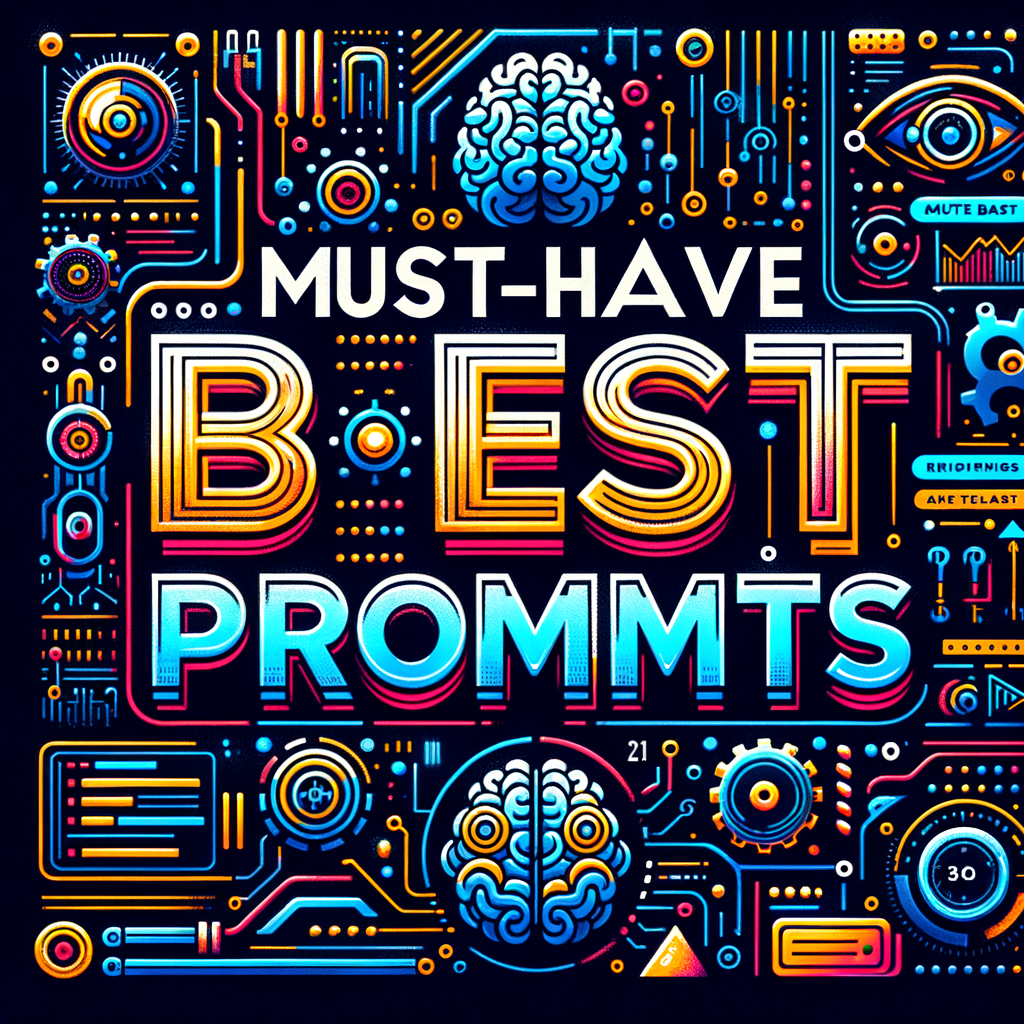
Ai Prompt Examples List: Must-Have Best Prompts
Introduction
Artificial intelligence now powers many creative and productive workflows. Yet, the quality of output depends on the prompts you write. This article presents an ai prompt examples list that includes must-have, high-impact prompts. You can copy, adapt, or build on them. Above all, you will learn how to write prompts that deliver useful, reliable results.
We will cover foundational prompt principles first. Then, we will group must-have prompts by use case. You will find templates, examples, and a handy table for quick reference. Finally, we will include tips for testing prompts, ethical guidance, platform options, and FAQs.
Why prompts matter
Prompts act as the bridge between your intent and the model’s output. If your prompt lacks clarity, the model guesses and may miss your goal. Conversely, a tight, well-structured prompt steers the model toward precise, actionable responses.
Moreover, better prompts save time. Instead of editing long outputs, you receive strong initial results. As a result, you can focus more on strategy and less on rework. This makes prompt mastery a high-leverage skill.
Core prompt design principles
First, be specific. Tell the model the outcome you want, the format, and any constraints. For example, specify word counts, tone, or audience. These details remove ambiguity and reduce revision cycles.
Second, show examples. If you provide a sample output, the model learns the pattern. Third, use step-by-step instructions when you need complex reasoning. Break tasks into numbered steps. Lastly, ask the model to self-check or explain its reasoning when accuracy matters.
How to read this ai prompt examples list
This ai prompt examples list groups prompts by task and use case. Each prompt includes a brief purpose and usage tips. You will find prompts for content, marketing, coding, data analysis, images, and productivity. Feel free to copy and paste them into your AI tool, then customize to fit your needs.
Also, notice that many prompts follow a similar pattern. They state the role, goal, format, constraints, and examples. You can reuse that pattern when creating your own prompts.
Content creation prompts
Blog outline generator
Purpose: Create a detailed blog post structure with headings, subheadings, and key points.
Prompt: “You are a content strategist. Create a detailed blog post outline about [topic]. Use H2 and H3 headings. Include at least 8 H2 sections and three bullet points under each H3. Suggest a catchy title and 5 SEO-friendly meta descriptions of 150 characters or less.”
Why it works: It specifies role, structure, and SEO outputs. You will get a practical blueprint to write the post quickly.
Long-form article writer
Purpose: Produce an in-depth article from an outline.
Prompt: “You are an experienced writer. Expand the following outline into a 1,200-word article. Use a friendly tone and short paragraphs. Include two examples, one statistic, and a conclusion that includes a call to action. Outline: [paste outline].”
Why it works: The prompt sets word count, tone, and elements to include. It prevents rambling and keeps content focused.
Copywriting and ad prompts
Short ad copy (social)
Purpose: Create short, attention-grabbing ad variations.
Prompt: “You are a creative copywriter. Write ten 25-word Facebook ad variants for [product/service]. Include a headline, primary text, and a call to action. Target audience: [describe audience]. Tone: [e.g., playful, urgent].”
Why it works: It limits length and asks for multiple variants. You can test which ad performs best quickly.
Email subject lines and bodies
Purpose: Improve open rates and conversions.
Prompt: “You are an email marketer. Write 8 subject lines and 4 email bodies for a promotion about [offer]. Each subject line should be 5–8 words. For each email, include a preview text and a clear CTA.”
Why it works: It focuses on measurable elements—subject length and CTA—for practical testing.
Marketing strategy and SEO prompts
SEO content brief
Purpose: Generate a content brief for writers and editors.
Prompt: “You are an SEO specialist. Create a content brief for a page targeting the keyword “[keyword]”. Include target intent, top 5 competitor URLs, suggested H1/H2s, target word count, internal links, and meta title and description suggestions.”
Why it works: It helps align writers with SEO goals and competitor context.
Customer persona and messaging matrix
Purpose: Clarify audience segments and messaging strategies.
Prompt: “You are a marketing strategist. Create 3 customer personas for [product]. For each persona include demographics, pain points, buying triggers, preferred channels, and 3 message angles with examples.”
Why it works: It produces actionable messaging tailored to segments, improving ad relevance and conversion.
Code and developer prompts
Code generation with constraints
Purpose: Produce code that meets specific rules and edge cases.
Prompt: “You are a senior developer. Write a Python function that converts UTC timestamps to local time zones. Support DST, validate inputs, and handle errors. Include type hints, docstrings, and unit tests with pytest.”
Why it works: It requires robust output with tests, which reduces bugs and clarifies expectations.
Debugging and code review
Purpose: Find bugs and suggest fixes in existing code.
Prompt: “You are a code reviewer. Inspect the following code and list bugs, security issues, and performance problems. Provide corrected code and a short explanation for each change. Code: [paste code].”
Why it works: It focuses the model on review tasks and asks for corrections, not just commentary.
Data, analytics, and spreadsheets
Data summary and visualization ideas
Purpose: Turn raw data into insights and graph ideas.
Prompt: “You are a data analyst. Summarize the key trends in this dataset and recommend five chart types to visualize the findings. Also, suggest pivot table layouts and three KPIs to track. Data description: [brief dataset summary].”
Why it works: It translates data into practical visualization and KPI recommendations.
Excel formula builder
Purpose: Create complex formulas or scripts for spreadsheets.
Prompt: “You are an Excel expert. Provide a formula that calculates a weighted average with dynamic ranges and ignores blank cells. Also, include an equivalent Google Sheets script using Apps Script.”
Why it works: It supplies both formula and script, so you can use either platform.
Image generation and prompts for visual AI
Image style and composition prompt
Purpose: Create reliable prompts for text-to-image models.
Prompt: “You are an art director. Write a stable, detailed prompt for a 4K image of [subject]. Specify camera angle, lighting, color palette, mood, art style, and any negative prompts. Example: ‘Close-up portrait of an elegant fox, golden hour lighting, shallow depth of field, warm tones, cinematic, photorealistic — no text, no watermarks.’”
Why it works: Image models need precise visual cues. This prompt lists them.
Logo concept generation
Purpose: Get multiple logo concepts and rationale.
Prompt: “You are a brand designer. Generate 6 logo concepts for [brand name]. For each concept, describe visual elements, color choices, typography, and a 15-word tagline. Mention potential iconography and variations for dark/light backgrounds.”
Why it works: It gives both creative directions and practical design notes.
Brainstorming and ideation prompts
New product ideas
Purpose: Produce a list of viable product concepts.
Prompt: “You are an innovation lead. Brainstorm 20 new product ideas for [industry] targeting [customer segment]. For each idea, include a one-sentence description, target problem, and 3 possible revenue models.”
Why it works: It expands options and links ideas to revenue, aiding decision-making.
Feature prioritization matrix
Purpose: Prioritize features for a product roadmap.
Prompt: “You are a product manager. Create a feature prioritization matrix for [product]. Use criteria: impact, effort, risk, and strategic fit. List top 10 features with scores and a recommended timeline (now, soon, later).”
Why it works: It provides a rational basis for roadmap decisions and timelines.
Productivity and personal assistant prompts
Daily planning and focus
Purpose: Create an optimized daily schedule.
Prompt: “You are an executive assistant. Build a focused daily plan for a busy professional. Include time blocks for deep work, meetings, breaks, and buffer time. Prioritize 3 main goals and list two tactical actions for each.”
Why it works: It gives structure and goal alignment. You will get an actionable schedule.
Meeting notes and action items
Purpose: Convert meeting transcripts into concise deliverables.
Prompt: “You are a note taker. Summarize the meeting transcript below into 5 key points, 7 action items with owners, and a one-paragraph summary for executives. Transcript: [paste transcript].”
Why it works: It saves time and clarifies next steps for teams.
Education and learning prompts
Lesson plan generator
Purpose: Produce structured lesson plans for different levels.
Prompt: “You are an educator. Create a 45-minute lesson plan on [topic] for [grade/level]. Include learning objectives, materials, step-by-step activities, formative assessments, and homework.”
Why it works: It delivers ready-to-use lessons that save prep time.
Explain like I’m five (ELI5)
Purpose: Simplify complex topics into plain English.
Prompt: “Explain [complex concept] as if to a curious 10-year-old. Use simple analogies, three short examples, and one real-world application. Limit to 200 words.”
Why it works: It forces the model to simplify language and use relatable examples.
Customer support and FAQs
Automated support responses
Purpose: Create empathetic, consistent responses to customer inquiries.
Prompt: “You are a support agent. Create a reply to a customer who reports [issue]. Apologize, explain likely causes, give three troubleshooting steps, and include escalation paths if unresolved. Tone: calm and helpful.”
Why it works: It ensures tone consistency and practical troubleshooting steps.
FAQ generation from product docs
Purpose: Build useful customer-facing FAQs quickly.
Prompt: “You are a technical writer. Read the following product documentation and generate 15 FAQs with short answers. Prioritize common search intents and include internal links to documentation sections. Docs: [paste docs].”
Why it works: It extracts common questions and pairs answers with doc links for discoverability.
Legal, compliance, and policy prompts
Contract clause drafts
Purpose: Draft practical contract language for common scenarios.
Prompt: “You are a contract specialist. Draft a limitation of liability clause for a SaaS contract with fair caps, exclusions for gross negligence, and indemnity language. Keep the clause concise but legally protective.”
Why it works: It produces starting language for legal review, saving drafting time.
Privacy policy checklist
Purpose: Create a privacy checklist tailored to a business.
Prompt: “You are a privacy consultant. Create a privacy policy checklist for a mobile app that collects location and usage data. Include legal requirements, consent flows, data retention, third-party vendor checks, and breach response steps.”
Why it works: It gives a practical compliance checklist to follow.
Table: Quick ai prompt examples list (by category)
| Category | Example Prompt Purpose | Short Prompt Template |
|—|—:|—|
| Content | Blog outline | “Create a detailed blog outline for [topic], H2/H3, SEO meta descriptions.” |
| Copywriting | Ads | “Write 10 Facebook ad variants for [product], 25 words each, include CTA.” |
| Marketing | SEO brief | “Generate an SEO content brief for keyword [keyword], include competitors.” |
| Code | Function + tests | “Write Python function for [task], include docstrings and pytest tests.” |
| Data | Visualization | “Summarize dataset trends and recommend 5 chart types and KPIs.” |
| Images | Visual prompt | “Write a 4K photorealistic prompt for [subject], include camera and lighting.” |
| Brainstorm | Product ideas | “Brainstorm 20 product ideas for [industry], include revenue models.” |
| Productivity | Daily plan | “Create a daily plan prioritizing 3 goals, with time blocks and tasks.” |
| Support | Troubleshooting | “Reply to customer with [issue], provide 3 steps and escalation info.” |
| Legal | Privacy checklist | “Create privacy checklist for mobile app that collects location data.” |
Prompt templates you can reuse
Role + Goal + Constraints pattern
Structure your prompts using this template:
– Role: define the model’s perspective.
– Goal: state the desired output clearly.
– Constraints: list length, format, tone, and examples.
Example: “You are a [role]. Produce [output type] about [topic]. Use [tone]. Limit to [length]. Include [elements].”
Step-by-step decomposition
When tasks require logical steps, instruct the model to plan and then execute.
Example: “Plan the approach in 3 steps. Then perform step 1. Finally produce the final output in JSON format.”
Multi-turn instruction with checkpoints
For iterative or long tasks, ask for progress checks.
Example: “Create sections A, B, C. After each section, show a 2-line summary. Wait for confirmation before proceeding.”
How to customize prompts for your needs
Adjust tone and audience
Always specify the audience and tone. A B2B whitepaper uses a formal tone. A social post benefits from playful, concise language. Changing tone alters word choice and structure quickly.
Change constraints for output format
If you need a table, JSON, code block, or CSV, say so. This reduces post-processing. Also, set length limits to control verbosity and time spent editing.
Prompt testing and iteration processes
Test with a small sample first
Run prompts on a single example before scaling. This step reveals ambiguities and edge cases quickly. Then tweak instructions and re-run.
Version your prompts and track results
Keep a prompt library with names and versions. Note which prompt variant gave the best outputs. Track metrics like time saved, accuracy, or stakeholder satisfaction.
Common prompt mistakes and how to avoid them
Vague asks lead to inconsistent results
Avoid prompts like “Write about X” with no structure. Instead, ask for specific sections, examples, tone, and length. Use example outputs to guide style.
Overloading with too many tasks
Long multi-task prompts often confuse the model. Break tasks into smaller prompts, then combine outputs. Use orchestration if you need end-to-end automation.
Ethical and safety considerations
Avoid generating harmful or personal data
Do not ask models to create defamatory, illegal, or privacy-invasive outputs. Always redact or anonymize personal data before sending it to a third-party AI.
Add guardrails and human review
When outputs influence decisions, add constraints and require human validation. For example, require a second review for legal, financial, or medical prompts.
Tools and platforms to run prompts
General-purpose models
Platforms like OpenAI, Anthropic, and Google provide flexible large language models. These models work well for most text tasks and quality varies by model.
Specialized tools and prompt managers
Several SaaS tools help you manage prompt libraries, run A/B tests, and add orchestration. Examples include PromptLayer, LangChain, and LlamaIndex. Use these to scale safely.
Prompt examples for advanced workflows
Chain-of-thought reasoning
Purpose: Force transparent reasoning for complex tasks.
Prompt: “You are a senior analyst. Show your reasoning step-by-step as you solve this problem. Then present the final answer separately. Problem: [describe problem].”
Why it works: It forces the model to expose its internal steps. Review steps to check for logical errors.
Role-play scenarios for negotiation or interviews
Purpose: Simulate realistic human interactions.
Prompt: “You are a tough negotiator with 10 years’ experience. Role-play a negotiation for a 12-month contract worth $X. Provide opening lines, objections, and counteroffers.”
Why it works: It creates realistic scripts and helps you rehearse responses.
Measuring prompt effectiveness
Define KPIs for your prompts
Set metrics like reduction in editing time, accuracy rate, customer satisfaction, or conversion uplift. Measure before and after to justify prompt improvements.
Run controlled A/B tests
Test prompt variants against each other. Use the same input set to compare outputs. Track outcomes to select the best-performing prompt.
Advanced tips for power users
Use system messages for role and tone
When available, put role and constraints in the system message. This reduces repetition and stabilizes behavior across prompts.
Combine prompts with retrieval
For knowledge-heavy tasks, use retrieval-augmented generation. Pull facts from a vetted source, then ask the model to synthesize. This increases factual accuracy.
Prompt library and governance
Create a searchable prompt library
Store prompts with metadata: purpose, owner, version, example outputs, and performance metrics. This helps teams reuse and adapt effective prompts.
Establish prompt governance
Define who reviews and approves prompts that affect customers or compliance. Apply access controls to prevent misuse.
Case studies and real-world examples
Marketing team speeds content production
A marketing team used this ai prompt examples list to create content briefs and article drafts. They cut content production time by 40%. As a result, the team published more and tested new topics faster.
Engineering team uses tests for code generation
An engineering team asked models to generate code plus unit tests. This practice reduced debugging time and sped reviews. However, they still required human validation before merging.
Final checklist before deploying any prompt
– Define the role and goal clearly.
– Set format, length, and tone constraints.
– Include examples or desired output.
– Test on small samples and edge cases.
– Add safety checks and human review.
– Version and track prompt performance.
Conclusion
This ai prompt examples list gives you practical, ready-to-use prompts for many everyday tasks. You will get better results when you apply the role+goal+constraints pattern. Moreover, test and iterate your prompts often. Keep ethical safeguards and human review in place for high-stakes uses. Finally, build your prompt library to scale wins across teams.
Frequently Asked Questions (FAQs)
1. How do I know which prompt will work best?
Start with a clear goal and test 3–5 variants. Measure outputs against a simple rubric. Then choose the best performer and iterate.
2. Can these prompts work with different AI models?
Yes. Most prompts work across major text models. You may need small tweaks for each model’s tone and token limits.
3. How do I prevent the model from (Incomplete: max_output_tokens)

